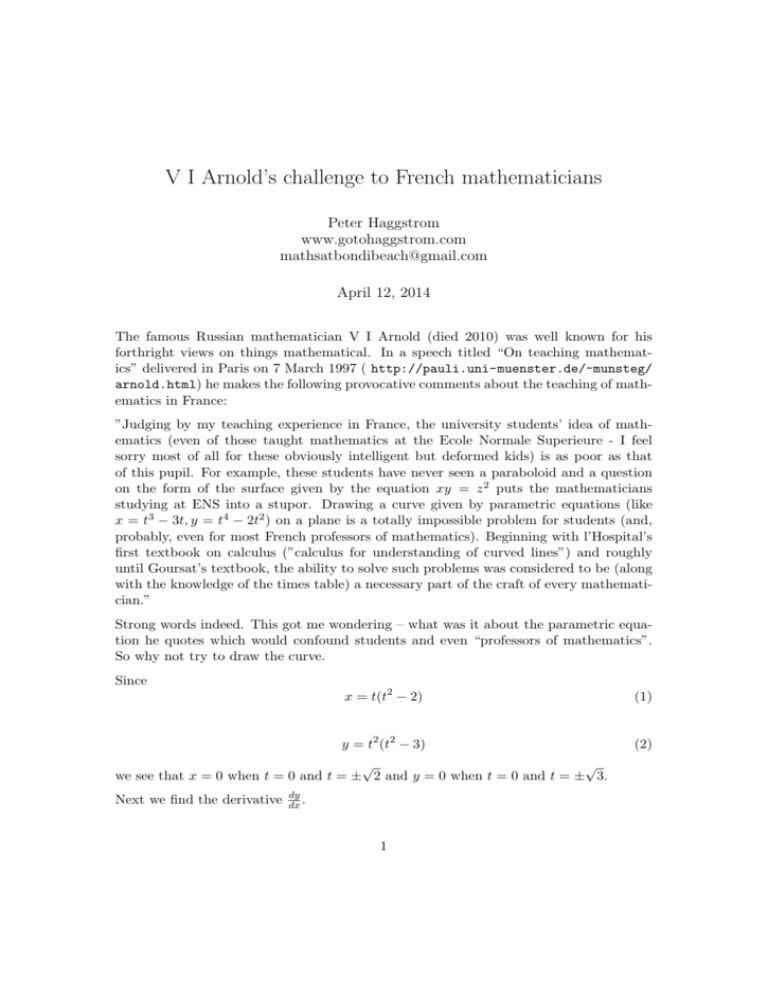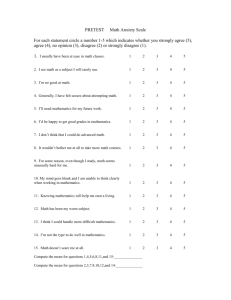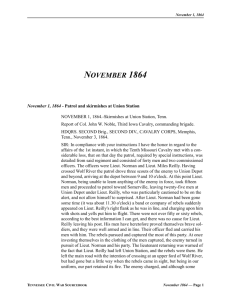V I Arnold's challenge to French mathematicians
advertisement

V I Arnold’s challenge to French mathematicians Peter Haggstrom www.gotohaggstrom.com mathsatbondibeach@gmail.com April 12, 2014 The famous Russian mathematician V I Arnold (died 2010) was well known for his forthright views on things mathematical. In a speech titled “On teaching mathematics” delivered in Paris on 7 March 1997 ( http://pauli.uni-muenster.de/~munsteg/ arnold.html) he makes the following provocative comments about the teaching of mathematics in France: ”Judging by my teaching experience in France, the university students’ idea of mathematics (even of those taught mathematics at the Ecole Normale Superieure - I feel sorry most of all for these obviously intelligent but deformed kids) is as poor as that of this pupil. For example, these students have never seen a paraboloid and a question on the form of the surface given by the equation xy = z 2 puts the mathematicians studying at ENS into a stupor. Drawing a curve given by parametric equations (like x = t3 − 3t, y = t4 − 2t2 ) on a plane is a totally impossible problem for students (and, probably, even for most French professors of mathematics). Beginning with l’Hospital’s first textbook on calculus (”calculus for understanding of curved lines”) and roughly until Goursat’s textbook, the ability to solve such problems was considered to be (along with the knowledge of the times table) a necessary part of the craft of every mathematician.” Strong words indeed. This got me wondering – what was it about the parametric equation he quotes which would confound students and even “professors of mathematics”. So why not try to draw the curve. Since x = t(t2 − 2) (1) y = t2 (t2 − 3) (2) √ √ we see that x = 0 when t = 0 and t = ± 2 and y = 0 when t = 0 and t = ± 3. Next we find the derivative dy dx . 1 Therefore When t > q 3 dy 2 , dx dx = 3t2 − 2 dt (3) dy = 4t3 − 6t dt (4) dy 2t(2t2 − 3) = dx 3t2 − 2 q dy > 0 and when t < − 32 , dx < 0. When t = 0, (5) dy dx =0 q When t = ± 23 , the derivative becomes unbounded which suggests that as the tangent moves from negative to positive, for instance, the tangent becomes vertical. Now suppose that t varies from −2 to 2 so that we get the following results: dy t = −2, x = −4, y = 4, dx = −2 √ √ dy t = − 3, x = − 3 ≈= −1.73, y = 0, dx ≈ −1.48 q dy 3 t = − 2 , x ≈ 0.61, y = −2.25, dx = 0 dy t = −1, x = 1, y = −2, dx =2 q 2 t = − 3 , x ≈ 1.09, y ≈ −1.56, dy dx unbounded dy t = 0, x = 0, y = 0, dx =0 q 2 t = 3 , x ≈ −1.09, y ≈ −1.56, dy dx unbounded dy t = 1, x = −1, y = −2, dx = −2 q dy 3 =0 t = 2 , x ≈ −0.61, y = −2.25, dx √ dy t = 3, x ≈ 1.73, y = 0, dx ≈ 1.48 dy t = 2, x = 4, y = 4, dx = 2 2 3 Using Mathematica the (x, y) graph looks like this: So what is the equation in terms of x and y? Because x4 = t12 − 8t10 + 24t8 − 32t6 + 16t4 and y 3 = t12 − 9t10 + 27t8 − 27t6 we see that: x4 − y 3 = t10 − 3t8 − 5t6 + 16t4 (6) The RHS of (6) can be found as sum of the relevant powets of x and y. To see what combinations are possible note that: x2 = 4t2 − 4t4 + t6 (7) y 2 = 9t4 − 6t6 + t8 (8) y = −3t2 + t4 (9) x2 y = −12t4 + 16t6 − 7t8 + t10 (10) 4 To get the RHS of (6) we need a linear combination of x2 , y 2 , y and x2 y ie ay 2 + by + cyx2 + dx2 (11) and then just solve for the coefficients. Thus we want to solve: t10 −3t8 −5t6 +16t4 = −3bt2 +4dt2 +9at4 +bt4 −12ct4 −4dt4 −6at6 +16ct6 +dt6 +at8 −7ct8 +ct10 t10 −3t8 −5t6 +16t4 = ct10 +(a−7c)t8 +(d+16c−6a)t6 +(9a+b−12c−4d)t4 +4dt2 −3bt2 (12) Equating coefficients we see that: c=1 a − 7c = −3 =⇒ a = 4 d + 16c − 6a = −5 =⇒ d + 16 − 24 = −5 =⇒ d = 3 9a + b − 12c − 4d = 16 =⇒ 36 + b − 12 − 12 = 16 =⇒ b = 4 Hence the RHS of (11) becomes: 4y 2 + 4y + yx2 + 3x2 (13) x4 − y 3 = 4y 2 + 4y + yx2 + 3x2 or y(4 + 4y + y 2 ) = x4 − x2 (y + 3) (14) So the equation has the form: Mathematica confirms this result using the command: You can read more about Arnold here: http://www.ams.org/notices/201203/rtx120300378p. pdf. His famous book Mathematical Methods of Classical Mechanics adopts his characteristic geometric approach to the area. I can’t see anything in this problem that would render it impossible for students let alone professors. It can be easily done with your bare hands. 5








